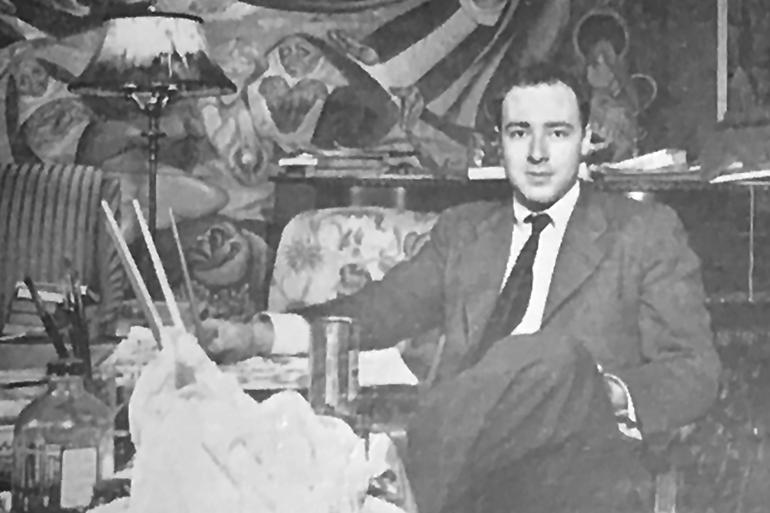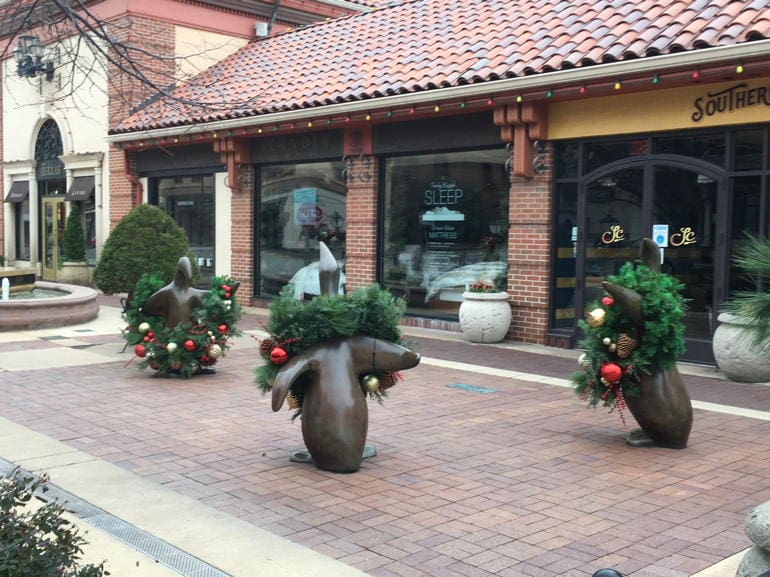Arthur Kraft: that wouldn’t be a good name for an artist in fiction (insert your own Arts and Crafts joke here), but he was a fine artist, none the less. Arthur, who was born in 1921, may have inherited some of his artistic ability from his mother, Mildred Mayfield Kraft, who designed and made flowers and neckwear during the mid-1930s. (Her flowers were a huge hit with the ladies at the Kansas City Lindenwood College Club at their spring luncheon in 1934.) His father was Charles Herbert Kraft, who worked for a business that supplied school equipment. (He is not to be confused with the Charles Herbert Kraft who was a founder of Kraft Cheese).
Arthur’s first formal instruction in art was at the Nelson Gallery (now The Nelson-Atkins Museum of Art). Interviewed for a Kansas City Times article in 1958, he reminisced, “‘After classes on Saturday mornings some of us would stay at the gallery and sketch,’ he says. ‘Then we would go back to sketch more on Sundays. In those days the guards at the gallery were students at the Art Institute, and they would give us lessons. It was like one big art class.’”
  |
|
Arthur Kraft in his studio at the Mission Woods Road home of his parents, Mr. and Mrs. Charles H. Kraft, where he has completed the execution of a collection of new paintings to be exhibited April 18 to May 7 in a one man showing in the Contemporary American Department of the Jacques Seligmann Gallery in New York. Reprinted from the April 16, 1949 issue of The Independent. |
Visitors to the Plaza Art Fair first glimpsed examples of Arthur’s creativity when he was 13. His initial offerings? Several hundred matchboxes decorated with pipe cleaners (he later recalled that the most popular ones looked like wire-haired terriers) and some oil portraits that were surprisingly sophisticated for one so young. Years later, in the 1950s, he exhibited his work in a booth shaped like a teepee at the Art Fair, along with Randall Jessee. (Randall was famous at the time, but not for his paintings. He was a broadcast journalist during the early days of television in Kansas City.)
After graduating from Southwest High School, Arthur briefly attended the Kansas City Art Institute and then went to Yale University, where he was the art editor of the Yale Record. During World War II, he served in the Army Air Corps in areas of the Pacific; by his own account, he mainly painted murals in officers’ clubs. In 1946, after resuming his studies, Arthur won first prize in the Audubon Artist Society’s annual exhibition, which was held at the Academy of Arts & Letters. His painting? New York as Seen by a Casual Observer Through my Great Aunt Jennifer’s Ouija Board. (Just stopping to read the title probably gave visitors an additional moment to contemplate the artwork. We should note that Jennifer was an old-fashioned name then, later to be revived in grand style.) He was busy creating illustrations for magazines when he learned that he was the winner of the Alice Kimball English Traveling Fellowship at Yale, which enabled him to spend months studying and painting in Europe. A show of his works was mounted at the Jacques Seligmann Gallery in New York in 1948.
By the mid-1950s, Arthur was back in Kansas City. Why? “One is likely to be more slowly devoured by American commercialism here than in New York,” he told a reporter. Then, too, Arthur liked keeping a multitude of animals, and he disliked subways. Going home didn’t mean retreating. In January 1955, the United States Junior Chamber of Commerce (better known as the Jaycees) listed him as one of the 10 outstanding young men in the nation for 1954. The organization asked Arthur to create a trophy for that same award in 1956.
Arthur’s commissions during the early years of his career included sculptures and mosaics. He loved drawing penguins, and they were featured in artwork done for a mall in Indiana. A laughing elephant graced a Michigan shopping mall. May 1958 saw the dedication of the new building for the Missouri Public Service Company (later Aquila) and also of the mosaic mural Arthur had designed for the entranceway. With help from assistants, art students, and friends, he used a staggering number (350,000!) of pieces of Byzantine glass tile to compose a history of the company. The artwork weighed 600 pounds. At one time, Arthur had several pieces prominently displayed in Downtown Kansas City. He created Family for a fountain at Commerce Bank and a wall mosaic featuring 80 colors of glass tile for the entrance to the Children’s Library at the Kansas City Public Library.

The later years of his life were marred by violence and addiction. In October 1959, when he was still in his thirties, Arthur was robbed and pistol-whipped. The attack took place in a parking lot in back of a tavern that was located at 5050 Main Street. Arthur suffered lacerations on his head and face, and he was hospitalized for more than a week. Two men later pled guilty; one of them had had Arthur’s wristwatch with him when he was arrested. How badly was Arthur injured? In his obituary in 1977, the Kansas City Times noted, “Kraft had struggled in recent years with health problems friends said were triggered by injuries he suffered in an assault in 1959.”
Arthur was an alcoholic. In addition to the trauma of that October night, his problems may have been exacerbated by “the pressures of living as a closeted gay man in the Midwest,” as Julie Denesha stated in a 2019 article. Then, too, he may have downplayed what he experienced during the war. Arthur spent five weeks as a patient in the alcoholic ward of the St. Joseph State Hospital in 1971. It was his second trip to a mental hospital. Arthur wrote a book, Sounds of Fury, filled with sketches and writings that were based on the people he saw there. It was published in a limited edition. (An aside to readers who missed the 1970s: A certain laissez-faire attitude seems to have prevailed. In his free time, Arthur was allowed to explore other areas of the hospital. Looking at it from the vantage point of 2021, what he was doing may violate our ideas of privacy – “informed consent” as we know it doesn’t appear to be something either Arthur or his publisher took into consideration. He meant no harm by it. Something else that may not be clear: Arthur was a courageous person to speak openly about his alcoholism in that era, when there was tremendous stigma attached to it.)
Arthur had been treated for cancer prior to his death at the Veteran’s Hospital in Topeka, Kansas, in September 1977. He was only 56 years old. More than four decades later, some of his work is still cherished, and other pieces have been neglected or lost. For collectors, there is still the happy possibility of future finds, at estate sales, auctions, and the like. The bronze figures in the Court of The Penguins first appeared on the Plaza in October 1979. More than 40 years later, Arthur’s penguins still delight: as solid as they are, they’re also dancing.
At this time, and for the immediate future, the Glore Psychiatric Museum, which is one of the four museums in the St. Joseph Museum complex, in St. Joseph, Missouri, is hosting an exhibition, Arthur Kraft: Sounds of Fury. To see excerpts online, please visit stjosephmuseum.wixsite.com/mysite/services. For more information, call 816-364-1209 or visit stjosephmuseum.org/glore-psychiatric-museum.
For further reading:
- Denesha, Julie. “New Fans Try To Revive The Legacy Of A Once-Great, Mostly Forgotten Kansas City Artist.” www.kcur.org/arts-life/2019-07-12/new-fans-try-to-revive-the-legacy-of-a-once-great-mostly-forgotten-kansas-city-artist
- Denesha, Julie. “Psychiatric Museum Exhibit Builds Momentum for the Comeback of Kansas City Artist Arthur Kraft.” www.kcur.org/arts-life/2020-01-21/psychiatric-museum-exhibit-builds-momentum-for-the-comeback-of-kansas-city-artist-arthur-kraft
- Dye, Robert M. “An Artist’s ‘Discarded Mannequins.’” Kansas City Times. February 10, 1972.
- Sanford, Bob. “Mural Containing 350,000 Tiles of Byzantine Glass Decorates New Building Here.” Kansas City Star. May 4, 1958.
- Sanford, Robert K. “For Kraft, Art Is a Merry Whirl.” Kansas City Times. September 30, 1958.
Also featured in the January 9, 2021 issue of The Independent
By Heather N. Paxton